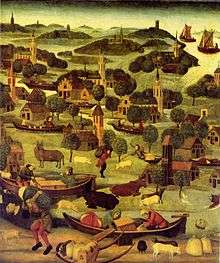St. Elizabeth's flood (1421)

The St. Elizabeth's flood of 1421 was a flooding of an area in what is now the Netherlands. It takes its name from the feast day of Saint Elisabeth of Hungary which was formerly November 19. It ranks 20th in the list of worst floods in history. During the night of November 18 to November 19, 1421 a heavy storm near the North Sea coast caused the dikes to break in a number of places and the lower lying polder land was flooded. A number of villages were swallowed by the flood and were lost, causing between 2,000 and 10,000 casualties. The dike breaks and floods caused widespread devastation in Zeeland and Holland.
The outcome
This flood separated the cities of Geertruidenberg and Dordrecht which had previously fought against each other during the Hook and Cod (civil) wars. Most of the land remains flooded even today.
Reclaimed parts
Most of the area remained flooded for several decades. Reclaimed parts are the Island of Dordrecht, the Hoeksche Waard island, and north-western North Brabant (around Geertruidenberg). Most of the Biesbosch (a big area of nature in the Netherlands) area has been flooded since.
Cause of the flood
The cause of the flood was a tidal surge, a combination of spring tide, northerly winds and low pressure like in the great flood of 1953 (see North Sea flood of 1953. Water from the storm in the North Sea surged up the rivers causing the dikes to overflow and break through. The flood reached a large sea arm between south-Holland and Zeeland or Zealand, destroying the Grote Hollandse Waard. At the lower point where the flood water reached the city of Dordrecht is the point where flood water still remains today.
See also
- St. Elizabeth's flood (1404)
- Dispute between Geertruidenberg and Dordrecht
- Floods in the Netherlands
- Kinderdijk
- List of disasters
References
External links
| Wikimedia Commons has media related to 1421 flood in the Netherlands. |